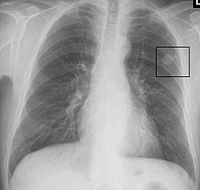
Photo from wikipedia
PURPOSE To develop and evaluate a three-dimensional (3D) generative model of computed tomography (CT) images of lung nodules using a generative adversarial network (GAN). To guide the GAN, lung nodule… Click to show full abstract
PURPOSE To develop and evaluate a three-dimensional (3D) generative model of computed tomography (CT) images of lung nodules using a generative adversarial network (GAN). To guide the GAN, lung nodule size was used. MATERIALS AND METHODS A public CT dataset of lung nodules was used, from where 1182 lung nodules were obtained. Our proposed GAN model used masked 3D CT images and nodule size information to generate images. To evaluate the generated CT images, two radiologists visually evaluated whether the CT images with lung nodule were true or generated, and the diagnostic ability was evaluated using receiver-operating characteristic analysis and area under the curves (AUC). Then, two models for classifying nodule size into five categories were trained, one using the true and the other using the generated CT images of lung nodules. Using true CT images, the classification accuracy of the sizes of the true lung nodules was calculated for the two classification models. RESULTS The sensitivity, specificity, and AUC of the two radiologists were respectively as follows: radiologist 1: 81.3%, 37.7%, and 0.592; radiologist 2: 77.1%, 30.2%, and 0.597. For categorization of nodule size, the mean accuracy of the classification model constructed with true CT images was 85% (range 83.2-86.1%), and that with generated CT images was 85% (range 82.2-88.1%). CONCLUSIONS Our results show that it was possible to generate 3D CT images of lung nodules that could be used to construct a classification model of lung nodule size without true CT images.
Journal Title: Computers in biology and medicine
Year Published: 2020
Link to full text (if available)
Share on Social Media: Sign Up to like & get
recommendations!